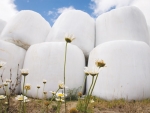
Losses occur as sugars and proteins in the grass are broken down by enzymes and bacteria, starting as soon as the grass is cut. Losses decrease quality and quantity, because the highly digestible components are the most rapidly broken down.
Losses depend firstly on the dry matter content of the pasture you ensile
Field losses: As cut pasture waits to be picked up, sugars are lost through a process of respiration. Drier pasture is more likely to be lost while being picked up, because it is more likely to break up or blow away. As the DM% of the pasture increases, so do field losses.
Fermentation losses: Plant sugars are used up during fermentation to make acid. In poorly preserved silage, protein and organic matter can also be lost because of air in the stack, or a high pH. Fermentation losses are lowest in pasture which is above 25% DM.
Effluent losses: Silage effluent is surplus water from the silage, carrying soluble sugars and proteins with it as it flows out. Effluent is produced from silage made out of low DM pasture. Above 30% DM, no effluent losses will occur.
Heating: In dry grass silage it is a challenge to achieve good compaction. Poor compaction causes air to penetrate the stack once it is opened. When air is present, yeasts are able to generate heat from sugars and even from lactic acid and cause losses by converting these nutrients into heat.
Optimum DM for silage is 25-30% because total DM loss is minimised and effluent losses will be minor. To achieve this:
Cut in the morning of a sunny day, for rapid wilting. Cutting after 1-2 days sunny weather will result in good sugar levels in the pasture, even when cut in the morning.
Avoid wilting for any more than 24 hours.
Compact the silage well. In a stack or pit, use the heaviest wheeled vehicle available. Tractor wheels should not sink into the pile of pasture any further than the depth of rubber. For baled silage make sure a high density baler is used.
Seal the stack completely with a weighted, airtight cover. Wash old polythene before use to avoid contamination with the wrong bacteria.
Don't re-open a covered stack to add more pasture on another day.
Where concrete-lined pits are not full, make a concave [ ) ] and not convex [ ( ] top, to avoid water seeping down the side of the pit.
Once the silage is sealed, nothing can be done to change the fermentation process. A good fermentation relies on no air being in the silage, and having plenty of sugar available to turn into lactic acid. Poor fermentation leads to big losses of protein quality. In poorly preserved silage protein is broken down into ammonia, which decreases the feed value of the silage.
Getting things right while the grass is being harvested will maximise the chance of having a good fermentation:
A fast wilt to 25-30% DM will leave good sugar concentration in the pasture.
Quick compaction and effective sealing will keep out oxygen, making conditions more suitable for bacteria to convert sugars into lactic acid.
Fast production of lactic acid will quickly reduce the pH, to prevent protein losses.
Silage begins to break down once exposed to air, and will begin to heat up as micro-organisms turn the remaining sugars and protein into heat and energy.
When feeding out, aim for as little time as possible between exposing the silage to air and the cows eating it.
High DM% silages are particularly prone to deteriorating when exposed to air. Deterioration increases as air temperature increases, so silage fed over summer will have higher losses than that fed in winter. Yeasts and moulds containing toxins may grow on deteriorating silage.
- silage
- DairyNZ
- losses